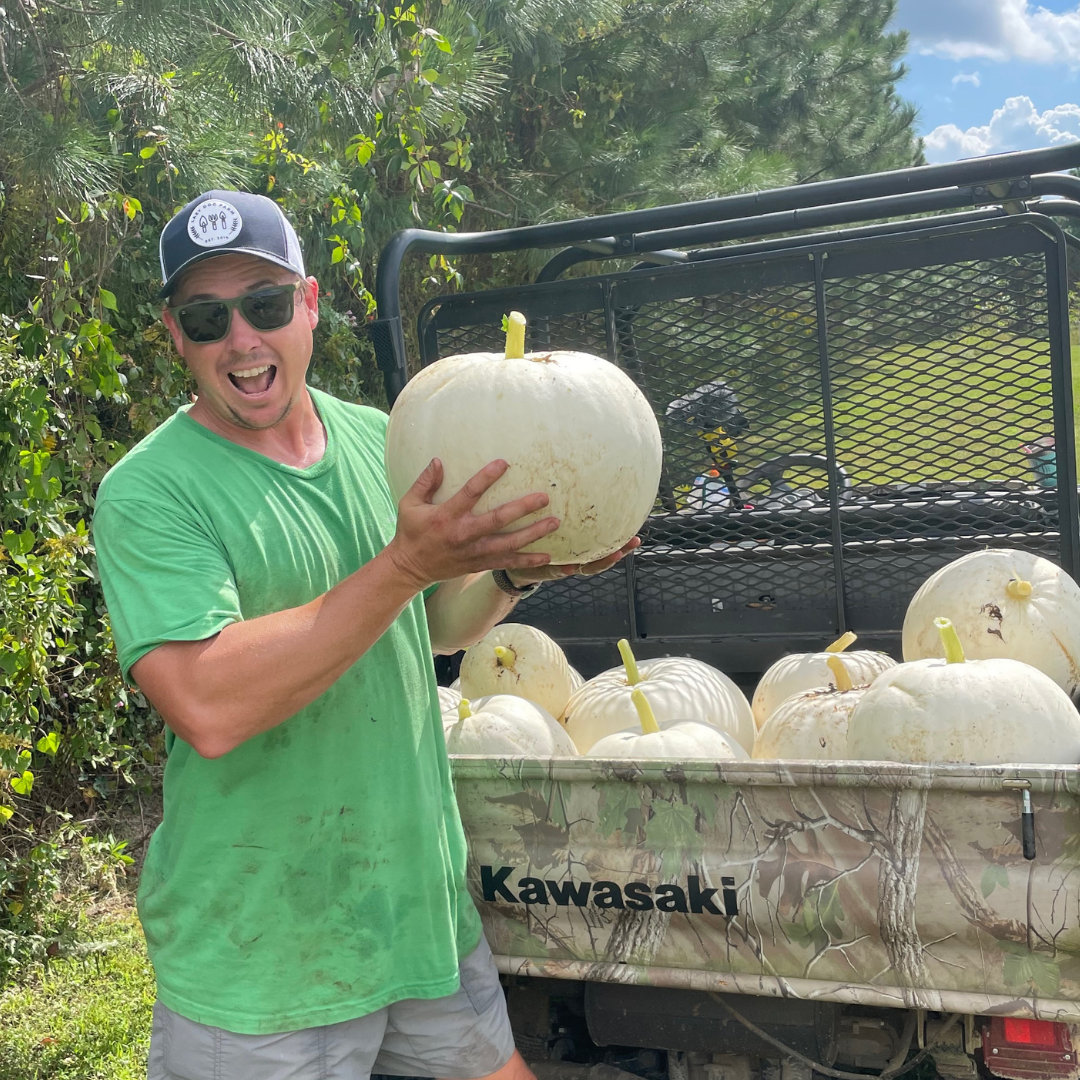While the primary purpose of our garden is to grow our own food, sometimes we like to grow things just because they're fun to grow. Pumpkins fall into that "fun to grow" category. We absolutely love growing pumpkins.
We do grow some pumpkins that are great to eat, but we also grow some that are solely for ornamental or decorative purposes. Thankfully, we have enough garden space that allows us grow plenty of food for our family and friends, but also grow some of these fun, decorative pumpkins.
We always have a pretty successful pumpkin/winter squash harvest from the spring planting, but growing fall pumpkins here in the deep south has always been a challenge. We have quite a few commercial farmers around here, and I've never seen any of them trying to grow pumpkins in the fall. There's probably a good reason for that.
All of the fall pumpkin stands around here buy pumpkins from Tennessee or farther north, because it just isn't very cost effective to grow them here for a fall harvest. It's easier for them to buy a truckload of pumpkins than to struggle with the intense pest and disease pressure that we experience in mid to late summer. As a result, I've always been a little reluctant to try growing a fall crop of pumpkins with hopes that they would be ready to harvest before Halloween.
The kids really enjoyed growing and harvesting our spring pumpkins and winter squash, so I figured I'd give it a try this year. I knew it was going to be difficult and I knew that my expectations compared to spring should be lowered, but I thought maybe I can get this to work a little. I knew we were going to battle with the extreme heat and humidity that is late summer in south Georgia, but it was worth a shot.
I decided to try this in two different plots. One plot was going to have three different types of pumpkins and winter squash, while the other plot was just going to have one variety. I planted later than I should have because the idea didn't hit me until late July. I got the seeds in the ground some time in early August. Ideally, I think I would need to plant in mid to early July for the pumpkins to be mature prior to Halloween. I also think planting transplants would be better than direct-seeding.
In the first plot, we planted an orange pumpkin called Igor, a butternut squash called Black Futsu, and an heirloom cushaw squash called Tug River Cushaw (sent to us by a viewer). In the second plot, we planted one long row of a white pumpkin variety called Polar Bear. Prior to planting, I had no idea which of these varieties (if any) would perform for a fall planting, but I figured I should try at least four different varieties to improve my chances.
Because I was less than optimistic, I also wanted to use this as opportunity to test intercropping a warm-season cover crop with the pumpkins. This would keep the soil covered in case the pumpkins were a complete failure, and hopefully keep the pumpkins shaded from the intense sun. We opted for iron clay pea as the warm-season cover crop to be interplanted with these pumpkins. We waited until the pumpkins germinated and started vining, then scattered the pea seed amongst the pumpkin plants so that the peas would cover the entire plot.

The interplanting of the iron clay peas worked very well. It served as a nice ground cover while the pumpkins were growing, suppressing weeds, retaining soil moisture, and providing shade to the fruits we did produce. As a result, I think I'll always interplant peas with pumpkins in the future. And I'm looking forward to discovering new combinations of cover crops and vegetable crops that grow well together.
In addition to adding the cover crop intercropping technique, I knew I was going to have to fertilize the pumpkin plants heavily to outpace any insect and disease issues. I used our fertilizer injector to feed them through our tripod sprinkler at least once every couple weeks. I used a rotation of Agrothrive and 20-20-20 which seemed to work well.
OUR FALL PUMPKIN RESULTS
The first plot, which included Igor, Black Futsu, and Tug River Cushaw, didn't germinate that great and never looked spectacular. The plants looked just okay for the first few weeks, but never really did anything. I saw a few flowers here and there, and did get a couple small cushaw squash. But that was it. The pest pressure in this plot was much higher than the other plot for some reason. So the results on that plot were terrible, but thankfully we had the pea cover crop as a backup plan.
The second plot, which included the Polar Bear Pumpkins, actually exceeded my expectations. We had a decent amount of vining on the plants, and were able to outpace the insect pressure. Surprisingly, we didn't have any disease pressure to note, but the insect pressure was intense. Some of the early leaves looked like a skeleton, but thankfully the new growth kept growing.

We typically like to wait and harvest pumpkins when the stalks are completely hardened and dry, but we didn't have that much time. Our late planting meant we were going to have to harvest these early if we were going to have them prior to Halloween. So in the second week of October, we entered the pumpkin and pea jungle to see what we could find.
Our Polar Bear Pumpkin harvest consisted of 16 pumpkins which were approximately 20-30 lbs each. The exterior of these were bright white and beautiful. Some were perfectly round, while others had a taller, oblong shape. Either way, we were more than happy with what we found and our limited success has us more than inspired to try again next year.
Things We Learned
1) I need to plant much earlier. As mentioned above, I likely need to plant in early to mid July, and I need to plant transplants as opposed to direct-seeding. This will ensure that the stems are nice and hardened prior to the second week of October when we would need to harvest the pumpkins.
2) The cover crop intercropping works wonderfully. Not only does this eliminate any need to weed the pumpkins as they grow, it also provides some nice shade to keep the color of the pumpkins from fading in the sun. Thirdly, it provides a solid backup plan if the pumpkins completely fail.
3) You have to fertilize A LOT! Although the disease pressure was surprisingly non-existent, the pest pressure for fall pumpkins is inevitable and intense. Besides spraying with Liquid Sevin (which we did), the only way to combat this is to push the plants so that they grow faster than the pests can damage them. This means that much of the early growth will become decimated at some point, but the later growth should continue to thrive.
4) Some varieties just can't hang! I don't really have a good way to determine if a particular variety is a good fall variety for us, except to try different ones and find ones that work. I know that smaller, heirloom varieties like Cherokee Tan and Seminole Pumpkin do well here in the fall, but we're going to have to continue to experiment to find the larger, ornamental varieties that work for fall planting down here.
I'm already excited for trying fall pumpkins next year! Although we didn't have a bumper harvest, I now know it can be done and have learned some valuable lessons that will hopefully improve the harvests in future years. I also know that fall pumpkins will never do as well as spring pumpkins down here, but I still think it's so much fun and worth a shot every year.

